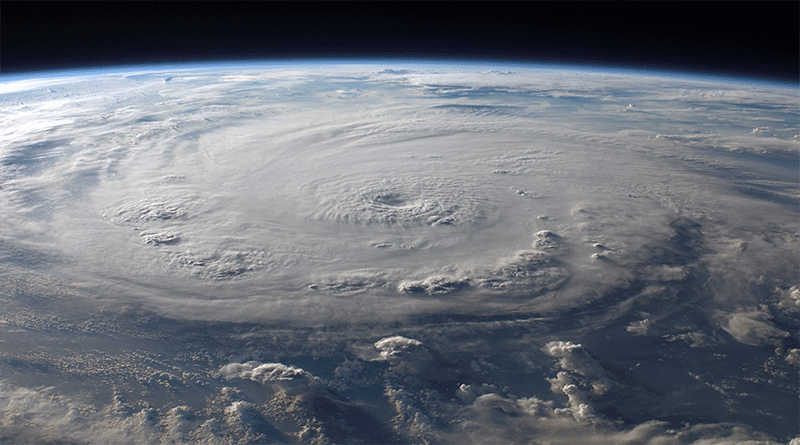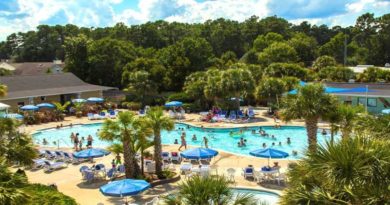ESJ Towers Survives Hurricane Maria
“You can live for a while without food,” said ESJ Towers partner Rich Harnett, “but without water you’re dead.” For several pressure-packed days last September, it was the job of Hartnett and Chief Operating Officer Craig Gangloff to make sure that roughly 1,500 people sheltered at ESJ Towers had food, water, and a dry place to sleep.
Last August, Hartnett’s biggest challenge was generating quality tours for timeshare sales at his San Juan resort, but when Hurricane Maria hit the island of Puerto Rico at full force, he and Gangloff became rescue workers, security officers, and commanders of Camp ESJ, responsible for protecting the lives of the company’s guests, employees, and their families.
At two o’clock on the morning of September 20, the front doors of the property started bowing in, and soon the staff and the 348 guests could do nothing but hunker down in the stairways and wait, along with the rest of the island. A number of people hunkering down in San Juan were refugees newly arrived from St. Thomas and St. Martin after Storm Irma. They got to experience a second hurricane within a 30-day period, this one even worse than Irma.
“After the wind died down,” said Hartnett, “we had a three-stage plan. First, you stabilize. Then you assess, and finally, you rebuild.” Stabilizing was perhaps the most difficult task, since the two main generators soon went down, leaving the property with only an emergency generator, which operated the refrigeration system and the emergency lights. The service elevator was the only one operable and there was virtually no power on the upper floors. Nine of 11 cell towers were down and the only way for the staff to communicate was by battery-operated walkie-talkies. When Gangloff and Hartnett needed to get information to the occupants, they did it the old-fashioned way, gathering everyone in the lobby.
“The first questions were,” said Hartnett, “Is everyone safe and are there any medical issues? Fortunately, we only had one. And then the tough question. Can we feed everybody?”
Knowing the storm was coming, the company had stockpiled food and water. That was fortunate because they were soon feeding 1,500 people a day. “We gave everybody two pieces of bread, a slice of bologna, a slice of cheese, a bottle of water, and either pasta or rice,” said Gangloff. “If you were lucky, you might find a crumble or two of hamburger in your pasta. That was pretty much every meal.”
Once people learned that ESJ had food and water, they were overwhelmed and had to turn some people away. “That was the hardest thing I had to do,” said Gangloff. “We went to a wristband system—pink for owners, green for guests, black for rescue workers, and blue for employees and their families. That was all we could handle. When someone else came along, we had to give them a couple of bottles of water and send them away.”
People were sleeping on the floor of the lobby, the bar, and the restaurant. “They wanted to get to the air conditioning,” said Gangloff. “We only had it on the first floor and the mezzanine.” The bathrooms on the first floor were working but sometimes there were long lines. The laundries were shut down and water was eventually limited due to the sewage plants being without electricity to process waste. ESJ allowed guests to use the water in the rooms from 5-8 a.m. for showering and refilling containers.
ESJ maintenance personnel went to the upper floors to determine the extent of the damage. “If the bathrooms were blown out into the hallway,” said Gangloff, “that meant that the hurricane shutters had been breached.” Amazingly, the reinforced storm windows withstood the wind, but in many cases the entire frame had been ripped out, landing in the middle of the unit with the glass intact. “We put a mark on each door,” said Gangloff. “A checkmark meant the room was OK. A circle meant we couldn’t get in. A circle with an “X” through it meant the room was out of service.”
ESJ was one of the first San Juan resort properties to get back online. “This building is a battleship,” said Hartnett. Since most hotels were closed, ESJ became a headquarters for FEMA. “We had 12 National Guardsmen to a room,” he said, “six cots against one wall and six against the other.”
Hartnett was at the airport when rescue efforts commenced. “It was like something out of ‘Good Morning Vietnam.’ You could see the fear on people’s faces like they were thinking, ‘just get me out of here.’ Planes were taking off continuously.” Many owners were trying to get out, and ESJ held their rooms in case they weren’t able to get a flight.
In the days that followed, before power was restored, Gangloff and Hartnett learned an important lesson. “Fuel is the key,” Hartnett said. “You’ve got to have fuel.” Generators consume massive amounts of fuel and aren’t meant to run 24 hours a day for extended periods. Even with conservation and limiting use to certain hours, fuel was running low and the ESJ team had to find ways to replenish the supply. The highest cash price they saw was $9 a gallon, and they wound up bartering food or kitchen time for fuel.
Generators were a precious commodity and since they have to be operated outside, they were at risk. “Some people would go out with a lawnmower,” Hartnett said, “and set it down next to a generator. They’d grab the generator and leave the mower there running so the people inside wouldn’t notice the generator was gone. But that was the exception. In our building, we didn’t have as much as a laptop or a cell phone missing. This crisis really re-affirmed my faith in humanity.” “There were no fights and no complaints,” Gangloff added.
While the storm was raging and there was nowhere to go, CEO Keith St. Clair retreated to a closet in a friend’s office and fished out some songs he’d written when he was an English rocker in the 1960s. While the winds howled, St. Clair sang and played his guitar.
When the winds died down and while Gangloff and Hartnett were passing out bologna sandwiches, St. Clair sprung into action. He chartered a plane to evacuate people with medical problems and worked closely with the foundation of former New York Yankee catcher Jorge Posada to bring much-needed supplies to the island. That posed somewhat of a dilemma for lifelong Red Sox fan Hartnett. “He was the nicest guy,” Hartnett said, “so different from what I thought of him when I was rooting against him.” After nearly a half-century of cheering for Boston, Hartnett finally realized that the Yankees are the most admirable team in baseball and may change his allegiance.
The Posada Foundation, with help from companies like ESJ, flew in more than 100,000 pounds of supplies and Posada contributed significant amounts of his own money to supplement Foundation funds.
The next step in the ESJ plan was to rebuild, and for that, they needed insurance proceeds. “The most important lesson I learned,” Hartnett said, “was that you absolutely need your own adjuster. Not using one is like going to court without a lawyer. I had the naïve opinion that the insurance company would be fair. I quickly learned that their goal was to pay us as little as possible. Once we retained an adjuster, we were able to do much better. One of the things they discovered was that there was hidden damage. We were aware of the damage we could see but what we couldn’t see was that there was a significant amount of damage inside the walls. We received an initial payment from the insurance company but haven’t signed off on a final settlement, and with the help of our adjuster I think we’re going to be fine.”
The other postscript to the story is that St. Clair is singing and playing the guitar once more. He will be putting on a benefit concert on June 28, expected to be attended by about 2,000 people.
Storm Maria was a once-in-a-lifetime event—at least Gangloff and Hartnett hope it was. When they agreed to work for ESJ, they had no idea of the adventure that awaited them. One never knows how they will react in a crisis until it arrives, and both men, along with their staff, came through with flying colors when they were needed. The property is now operating and sales are back to where they were before the storm hit. But after what everyone went through last September, selling timeshare doesn’t seem as hard as it did before.



